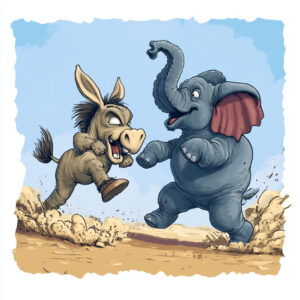 Back when it appeared that being pro-democracy was good for business, companies such as Coca Cola, Delta and Major League Baseball condemned Georgia’s restrictive voter laws and some even took action by taking their business out of the state. This angered Senator Mitch McConnell and he warned corporations to “…stay out of politics.” Unironically, he hastened to add that this does not include political contributions. This statement exemplified the Republican view that corporations should be paying politicians to do politics for them and not doing it themselves.
Back when it appeared that being pro-democracy was good for business, companies such as Coca Cola, Delta and Major League Baseball condemned Georgia’s restrictive voter laws and some even took action by taking their business out of the state. This angered Senator Mitch McConnell and he warned corporations to “…stay out of politics.” Unironically, he hastened to add that this does not include political contributions. This statement exemplified the Republican view that corporations should be paying politicians to do politics for them and not doing it themselves.
McConnell went on to threaten corporations, asserting that they were acting like a “woke parallel government.” While Republicans advanced the narrative that the out-of-control left was pushing cancel culture, Republicans urged consumers to boycott these companies to pressure them into changing their behavior. They also called for state legislatures to punish these companies using the power of the state.
Some might accuse the right and McConnell of being inconsistent. On the one hand, this does have some plausibility. After all, when the right attacks what they call “cancel culture” they profess to value free expression and contend that the left is acting wrongly by coercing corporations into doing their bidding. Alternatively, they accuse the corporations of being woke and imposing their values on others and thus presumably imposing on consumer choice by restricting or changing products. But McConnell was explicitly threatening corporations with the power of the state. Republicans profess to accept that corporations are people, that they thus have free speech rights, and that money is speech. As such, this violated their professed principles: they were the ones trying to cancel free speech. McConnell also explicitly advanced two inconsistent views: corporations should stay out of politics while making political contributions. But that is impossible: campaign contributions are political by nature.
It is interesting to compare this past situation with what happened to Tesla. After Elon Musk set out in apparent ignorance and malice to chainsaw the government, Tesla became the target of boycotts and even sabotage. While the right has famously boycotted “woke” companies, Trump claimed that the boycott was illegal and essentially did a commercial for Tesla.
On the other hand, if one ignores the surface rhetoric of the Republicans and McConnell and attempts to sort out their likely principle, then the inconsistency is dissolved. McConnell’s core principle seems to be that corporations should do what benefits McConnell. Engaging in political speech that opposes the Republican agenda of voter restriction was contrary to McConnell and Republican interests, so they threatened corporations to “cancel” their speech. Corporate contributions to McConnell and his fellow Republicans serve their interests, so they wanted the money to keep flowing. Corporate contributions to the Democrats also help the Republicans as Democrats who accept corporate money act in the interests of these corporations, which is what Republicans usually want.
The Republican party has shifted from a traditional pro-business approach to focus more on appealing to the Trump base and this has put them at odds with corporations. But one should not be tempted to think that the Republicans are going leftist and becoming pro-worker and anti-business.
The left has historically been critical of corporate involvement in politics for a variety of reasons. One is that corporations have great economic power and court rulings have enabled them to translate this directly into effectively unlimited political power. The other is that corporations tend to use their economic and political powers in ways that are detrimental to what the left professes to care about such as the environment and people outside of the top 1%. The left has, however, learned to adapt to this corporate power. Some people have figured out that they can influence corporations through consumer pressure and thus, somewhat ironically, sometimes get corporations to support what the right would tend to see as leftist, such as maximizing citizen participation in elections. It is not that corporations were taken over by woke leftists; they were simply keeping an eye on the bottom line: they rely on consumers for their profits and need to ensure that they present the right brand and products to maximize profits. Because most Americans were not on the far right, appealing to most consumers sometimes made corporations appear to be on the left in some ways.
But, as I have argued in other essays, these corporations are do not have leftist policies that would harm their bottom line. Corporations focus on profits and act accordingly. We did not see, for example, Amazon embracing unions. We did not see McDonald’s rushing to raise workers’ salaries and benefits. As such, the alleged wokeness of corporations was mostly just marketing and branding. If they were truly leftist, then they would not have operated as they did. That said, these corporations have done things that Republicans saw as contrary to their interests.
I do partially agree with McConnell: corporate influence in politics needs to be reduced. McConnell gets this when he is the one being harmed. But my view is based on a broader principle: I am not solely concerned with the harm to me; I am concerned about the general harm. When corporations acted in ways McConnell liked, he was happy to allow them unlimited expression. But if they expressed views he disliked, he was quick to threaten to “cancel” them for exercising the powers the Republicans gave them. McConnell’s solution was for the state to use its coercive power to threaten corporations into acting as Republicans wish. But this does not address the underlying problem: corporations have disproportionate power, and this is corrosive to democracy. Reducing that power would still allow the corporate rulers to express themselves, but it would allow others to use their freedom of expression more effectively. As my usual analogy goes, corporate America has a stadium sound system to blast its speech while most citizens are limited to trying to yell over that blast. So, we should not “cancel” corporations, but their power needs to checked and balanced.


 Back in the last pandemic, the right was busy with their eternal manufactured culture war. Manufacturing this war often involves using hyperbole and lies. Some years ago, the right was outraged about
Back in the last pandemic, the right was busy with their eternal manufactured culture war. Manufacturing this war often involves using hyperbole and lies. Some years ago, the right was outraged about  From a pragmatic standpoint, Republicans generally oppose D.C. statehood because it would almost certainly result in two Democratic senators and some Democratic House members. Democrats generally support statehood for this reason.
From a pragmatic standpoint, Republicans generally oppose D.C. statehood because it would almost certainly result in two Democratic senators and some Democratic House members. Democrats generally support statehood for this reason.  During the last pandemic, I contracted COVID and it was the sickest I have been in my life. Not being
During the last pandemic, I contracted COVID and it was the sickest I have been in my life. Not being  Before, during and after the 2020 election
Before, during and after the 2020 election  In response to each mass shooting, Democrats usually propose gun control legislation while Republicans offer “thoughts and prayers” while blocking the Democrats as best they can. Some years ago, Republican Senator John Kennedy said that
In response to each mass shooting, Democrats usually propose gun control legislation while Republicans offer “thoughts and prayers” while blocking the Democrats as best they can. Some years ago, Republican Senator John Kennedy said that  The right-wing news, certain pundits and certain politicians made
The right-wing news, certain pundits and certain politicians made